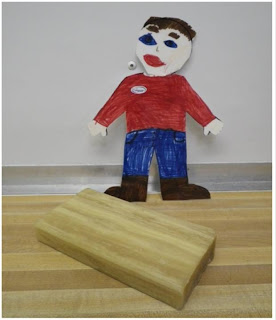Today I continued my
tour with the division of Agriculture Education and Outreach at the Department
of Agriculture in Kentucky. I started the day early and traveled all the way to
Vine Grove, Kentucky which is located just outside of Elizabethtown. We were
visiting Jason Hodge, Mobile Science Center Coordinator, to watch him teach
students about soil erosion and how to make lip balm!

We started with the soil erosion demonstration. Jason has a
cart that demonstrates a field that is covered in nice green grass on one side,
a corn field that has been harvested in the middle and a bare ground field on
the other side. He challenges students to think about which field will have the
most erosion. Erosion happens when soil is broken down by wind, water and ice.
Jason takes water and pours it over each field to make it “rain” on the ground.
A student catches the water underneath the soil cart to see how much erosion
occurred. The field that was covered in grass had nice clear water, meaning
there was very little to no erosion of the soil. The Corn field in the middle
had brown water with a little bit of dirt swirling around inside the cup. This
meant that there was some soil erosion that occurred. In the last dry mud
field, the water was dark brown with chunks of dirt in the water. This showed
that there was a lot of soil erosion. So what helped so much in the field with
the green grass? The roots! They help hold the soil in place!

I was able to help
Jason set up for the lip balm demonstration. He is making lip balm out of bee’s
wax, vegetable oil and flavoring- to make it smell nice! I am standing beside
the hot plates that he uses to melt the bee’s wax. I had to be very careful
because it was HOT!
When Jason gets the
bee’s wax, it comes in a solid block form. Jason shows the students that you
have to heat up the bee’s wax to change it to a liquid to make lip balm. He
talks to them about states of matter: liquids, solids and gases. You will learn
more about this later on in elementary school! The bee’s wax is hard and kind
of looks like wood!
Jason adds the vegetable oil to the melted bee’s wax. You
know what? Even though it is labeled “vegetable oil” it really is 100% soybean
oil. In my travels around Kentucky, I have learned that soybeans are one of the
top commodities grown here. They are known as the farmer’s “miracle crop” and
are used in everything from crayons, ink, counter tops, baby formula and so
much more! Who knew a bean could do all of that!
 After he mixes the
wax and oil together, he adds flavoring. Jason has an oil flavoring for one
batch and a water based flavoring for another batch. He shows the students that
the oil flavoring blends very easily with the vegetable oil and wax, making a
solution, which cannot be separated. When Jason adds the water based flavoring,
he had to use a magnet to keep the mixture stirring. Water does not blend
easily with oil. If Jason stopped stirring, the water would separate from the
oil and sink to the bottom. Because they separate out, it is known as a
mixture, but that is more of that stuff you will learn later in 3rd
or 4th grade!
After he mixes the
wax and oil together, he adds flavoring. Jason has an oil flavoring for one
batch and a water based flavoring for another batch. He shows the students that
the oil flavoring blends very easily with the vegetable oil and wax, making a
solution, which cannot be separated. When Jason adds the water based flavoring,
he had to use a magnet to keep the mixture stirring. Water does not blend
easily with oil. If Jason stopped stirring, the water would separate from the
oil and sink to the bottom. Because they separate out, it is known as a
mixture, but that is more of that stuff you will learn later in 3rd
or 4th grade!
When it was all done, Jason put the lip balm in plastic
containers with lids for the students to take home! I even got to pick out my
own – my lips have been pretty chapped in this cold Kentucky weather! Yum! I
picked orange flavor!
If you would like to know more about what Jason and his friend, Matthew, do with the Kentucky Department of
Agriculture’s Mobile Science Centers, check us out here!
What a great program!! I wish every state had a program similar! What does your state do to bring ag to kids? I'd love to read all the different things each state does!





